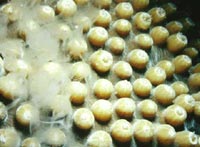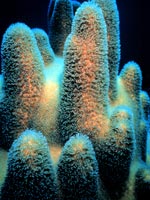This article is reposted from the old Wordpress incarnation of Not Exactly Rocket Science. The blog is on holiday until the start of October, when I'll return with fresh material.
Every month, at the full moon, tourists and students gather on the beach at Koh Phangan, Thailand for a night of booze, dancing, and debauchery. But the moon-themed antics of these party-goers look positively tepid when compared to those of the Great Barrier Reef's corals. With the help of two genes and a spot of moonlight, the corals synchronise one of the greatest spectacles of the natural world - a mass annual orgy.
When it comes to sex, corals play a numbers game. Encased in their rocky shells, direct contact is out of the question so they reproduce by releasing millions of eggs and sperm directly into the surrounding water.
This strategy only makes sense if all the corals release their sex cells en masse and sure enough, every individual within a third of a million square kilometres of reef does so during the days after the October full moon.
The corals' co-ordination would put even the most organised flash-mobs to shame and until now, scientists had no idea how they did it, especially with neither eyes nor brains. Aside from the obvious contribution of moonlight, the only other available clue was that corals seem to be especially sensitive to blue light.
 For Oren Levy and colleagues at the University of Queensland, that was enough. They noted that blue light sets the body clocks of many other animals via a group of proteins called the cryptochromes, or CRYs. These have been found in higher animals like flies, frogs and mice, and their distant cousins have even been reported in plants and bacteria.
For Oren Levy and colleagues at the University of Queensland, that was enough. They noted that blue light sets the body clocks of many other animals via a group of proteins called the cryptochromes, or CRYs. These have been found in higher animals like flies, frogs and mice, and their distant cousins have even been reported in plants and bacteria.
Using these known versions, Levy managed to identify two cry genes in the coral Acropora millepora. Much like their counterparts in more advanced animals, the levels of coral cry genes rise and fall to a daily rhythmic pulse. By sampling corals throughout the day, Levy showed that the coming of daylight turns on both genes, although they're slightly out of sync with each other.
More importantly for the annual orgy, cry2 responds to moonlight too. In the spawing season, the full moon doubled the abundance of this gene in the corals over the baseline levels during the new moon.
While it doesn't provide the whole story, the identification of cry2 certainly gives Levy and other scientists a starting point for uncovering other links in the chain of events between moonlight and spawning. And it also gives us a window into the early ancestors of modern animals.
 Corals are incredibly ancient animals and split off from the rest of the kingdom not long after the very earliest multi-celled animals evolved. The presence of light-sensitive CRYs in corals suggest that the most primitive animals also had genetic body clocks that responded to light, long before the first eyes evolved.
Corals are incredibly ancient animals and split off from the rest of the kingdom not long after the very earliest multi-celled animals evolved. The presence of light-sensitive CRYs in corals suggest that the most primitive animals also had genetic body clocks that responded to light, long before the first eyes evolved.
Levy suggests that these light-sensitive clock proteins evolved to protect the early animals from the harmful effects of ultraviolet (UV) radiation. UV rays damage DNA but a primitive group of proteins called photolyases can repair this damage by harnessing the energy of blue light. It's no coincidence that photolyases are the closely related to CRYs.
Levy believes that during the time of the first animals, much higher levels of UV radiation pummelled the planet's surface, forcing our early ancestors to retreat deeper into the ocean. There, they adapted their blue-sensitive photolyases to tell them when the sun had set and when it was safe to surface again. Eventually, these proteins became CRYs, the molecular equivalent of a Swiss watch.
More on corals:
- Bleached corals recover in the wake of hurricanes
- Worrying slowdown of coral growth in the Great Barrier Reef
- Corals survive acid oceans by switching to soft-bodied mode
- Fishing bans protect coral reefs from devastating predatory starfish
- One in three species of reef-building corals face extinction
Reference: Levy, Appelbaum, Leggat, Gothlif, Hayward, Miller & Hoegh-Guldberg. 2007. Light-responsive cryptochromes from a simple multicellular animal, the coral Acropora millepora. Science 318: 467-470
- Log in to post comments




Is the movie taken at Ningaloo Marine Park? If so, that area is on the opposite side of Australia. Arguably, the area is more spectacular than the Great Barrier Reef.